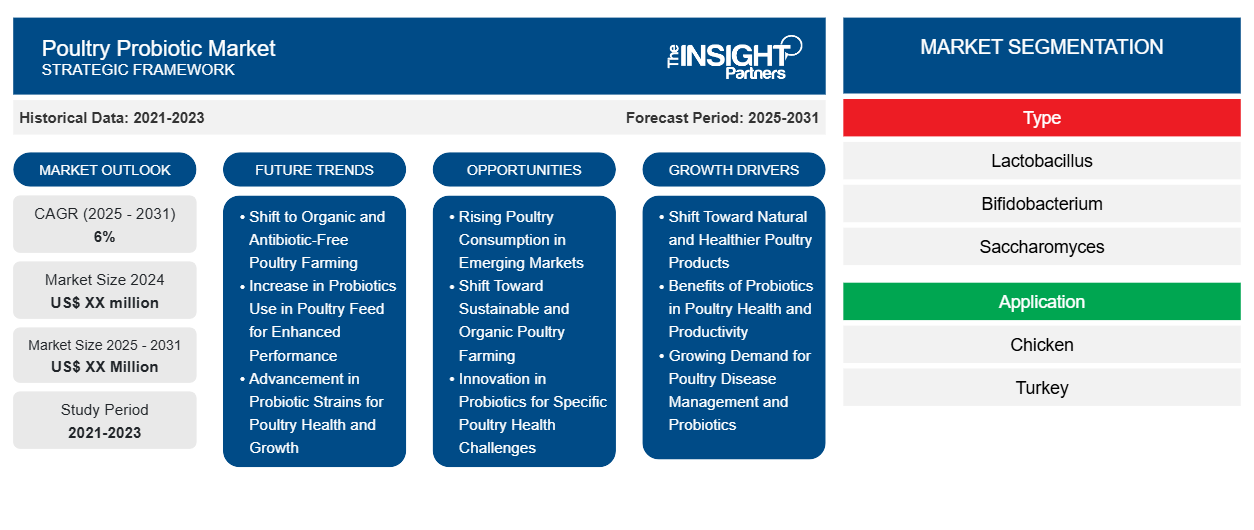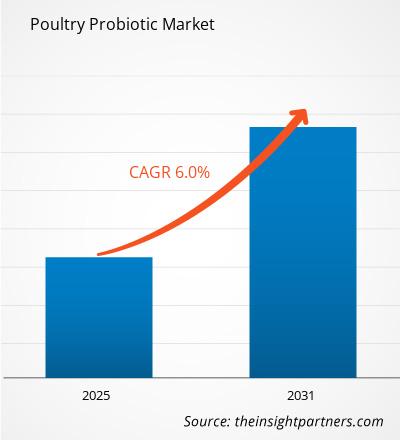Poultry Probiotic Market Regional Share, Size, Segmentation and Forecast by 2031
Historic Data: 2021-2023 | Base Year: 2024 | Forecast Period: 2025-2031Coverage: Poultry Probiotic Market covers analysis By Type (Lactobacillus, Bifidobacterium, Saccharomyces, Streptococcus, and Others), Application (Chicken, Turkey, and Others), and Geography
- Report Date : Mar 2026
- Report Code : TIPRE00030303
- Category : Food and Beverages
- Status : Upcoming
- Available Report Formats :


- No. of Pages : 150
The Poultry Probiotic Market is expected to register a CAGR of 6% from 2025 to 2031, with a market size expanding from US$ XX million in 2024 to US$ XX Million by 2031.
The report is segmented by type (Lactobacillus, Bifidobacterium, Saccharomyces, Streptococcus, and Others). The report further presents analysis based on application (chicken, turkey, and others). Global analysis is further broken-down at regional level and major countries. In terms of geography, the market is divided into North America, Europe, Asia Pacific, Middle East and Africa, and South and Central America). The report offers the Value in USD for the above analysis and segments.
Purpose of the Report
The report Poultry Probiotic Market by The Insight Partners aims to describe the present landscape and future growth, top driving factors, challenges, and opportunities. This will provide insights to various business stakeholders, such as:
- Technology Providers/Manufacturers: To understand the evolving market dynamics and know the potential growth opportunities, enabling them to make informed strategic decisions.
- Investors: To conduct a comprehensive trend analysis regarding the market growth rate, market financial projections, and opportunities that exist across the value chain.
- Regulatory bodies: To regulate policies and police activities in the market with the aim of minimizing abuse, preserving investor trust and confidence, and upholding the integrity and stability of the market.
Poultry Probiotic Market Segmentation
Type
- Lactobacillus
- Bifidobacterium
- Saccharomyces
- Streptococcus
Application
- Chicken
- Turkey
You will get customization on any report - free of charge - including parts of this report, or country-level analysis, Excel Data pack, as well as avail great offers and discounts for start-ups & universities
Poultry Probiotic Market: Strategic Insights

-
Get Top Key Market Trends of this report.This FREE sample will include data analysis, ranging from market trends to estimates and forecasts.
Poultry Probiotic Market Growth Drivers
- Shift Toward Natural and Healthier Poultry Products: The growing consumer inclination towards more natural and healthier chicken products is causing the reduction of the use of antibiotics in poultry production. An alternative to antibiotic use, which is a probiotic for poultry, is gaining popularity and is therefore boosting the market.
- Benefits of Probiotics in Poultry Health and Productivity: In poultry, the use of probiotics enhances digestion, nutrient uptake and the health of the birds, all of which lead to improved productivity. As farmers become more informed about the role of probiotics in enhancing the welfare of animals and decreasing the mortality rate, their use is rising thus contributing to the growth of the market.
- Growing Demand for Poultry Disease Management and Probiotics: Considering the increase in population and consumption of poultry meat and eggs most particularly in the third world countries, there is a demand for better management of poultry diseases. Probiotics allow a better feed conversion ratio and offers good health to the animals, thus providing an important supplementary factor of production which is increasing market growth.
Poultry Probiotic Market Future Trends
- Shift to Organic and Antibiotic-Free Poultry Farming: The usage of synthetic additives and antibiotics is being replaced with the use of more organic products such as poultry probiotics. As the consumers request more clean, pork free chicken, the farmers are utilizing antibiotics free products such as probiotics to ensure healthy and productive animals in tandem with environmentally friendly farming methods.
- Increase in Probiotics Use in Poultry Feed for Enhanced Performance: The incorporation of probiotics in compounded feeds is now on the increase. Farmers and feed producers seek to enhance the diets of poultry by utilizing probiotic research in order to improve on the birds’ gut health and general performance and therefore facilitating the integrated and holistic approach to poultry nutrition practiced today.
- Advancement in Probiotic Strains for Poultry Health and Growth: In poultry probiotic market growth trend changes in probiotic strains can be observed as more moderated products designed for customer demand in poultry health appear. There are changing trends in regard to the market as revolutionized probiotics intended to prevent diseases and promote growth of poultry are being manufactured due to advancement in microbial technology.
Poultry Probiotic Market Opportunities
- Rising Poultry Consumption in Emerging Markets: Emerging countries, especially in Asia and Africa, are increasing their poultry consumption, which paves the way for the use of probiotics for the betterment of poultry health and production. Emergence of modern farming practices in these areas has created a need for probiotics in poultry farming.
- Shift Toward Sustainable and Organic Poultry Farming: The increased attention to sustainable and organic poultry farming immediately points to possibilities for use of probiotics Furthermore, natural additives help fight the fear of over use of antibiotics as more and more consumers demand organic poultry products with no antibiotics.
- Innovation in Probiotics for Specific Poultry Health Challenges: There is an opportunity to innovate and provide specific probiotics that tackle intestinal health, disease intervention, and weight gain problems of poultry. The poultry market is also likely to experience growth from providing different solutions aimed at the different growth stages of poultry or even different breeds of poultry.
Poultry Probiotic Market Regional Insights
The regional trends and factors influencing the Poultry Probiotic Market throughout the forecast period have been thoroughly explained by the analysts at The Insight Partners. This section also discusses Poultry Probiotic Market segments and geography across North America, Europe, Asia Pacific, Middle East and Africa, and South and Central America.
Poultry Probiotic Market Report Scope
| Report Attribute | Details |
|---|---|
| Market size in 2024 | US$ XX million |
| Market Size by 2031 | US$ XX Million |
| Global CAGR (2025 - 2031) | 6% |
| Historical Data | 2021-2023 |
| Forecast period | 2025-2031 |
| Segments Covered |
By Type
|
| Regions and Countries Covered |
North America
|
| Market leaders and key company profiles |
|
Poultry Probiotic Market Players Density: Understanding Its Impact on Business Dynamics
The Poultry Probiotic Market is growing rapidly, driven by increasing end-user demand due to factors such as evolving consumer preferences, technological advancements, and greater awareness of the product's benefits. As demand rises, businesses are expanding their offerings, innovating to meet consumer needs, and capitalizing on emerging trends, which further fuels market growth.

- Get the Poultry Probiotic Market top key players overview
Key Selling Points
- Comprehensive Coverage: The report comprehensively covers the analysis of products, services, types, and end users of the Poultry Probiotic Market, providing a holistic landscape.
- Expert Analysis: The report is compiled based on the in-depth understanding of industry experts and analysts.
- Up-to-date Information: The report assures business relevance due to its coverage of recent information and data trends.
- Customization Options: This report can be customized to cater to specific client requirements and suit the business strategies aptly.
The research report on the Poultry Probiotic Market can, therefore, help spearhead the trail of decoding and understanding the industry scenario and growth prospects. Although there can be a few valid concerns, the overall benefits of this report tend to outweigh the disadvantages.
Frequently Asked Questions
What are the driving factors impacting the poultry probiotic market?
What are the future trends of the poultry probiotic market?
Which are the leading players operating in the poultry probiotic market?
Based on geography, which region held the largest share of the poultry probiotic market?
What are the deliverable formats of the poultry probiotic market?
What is the expected CAGR of the Poultry Probiotic Market?
Habi is a seasoned Market Research Analyst with 8 years of experience specializing in the Chemicals and Materials sector, with additional expertise in the Food & Beverages and Consumer Goods industries. He is a Chemical Engineer from Vishwakarma Institute of Technology (VIT) and has developed deep domain knowledge across industrial and specialty chemicals, paints and coatings, paper and packaging, lubricants, and consumer products. Habi’s core competencies include market sizing and forecasting, competitive benchmarking, trend analysis, client engagement, report writing, and team coordination—making him adept at delivering actionable insights and supporting strategic decision-making.
- Historical Analysis (2 Years), Base Year, Forecast (7 Years) with CAGR
- PEST and SWOT Analysis
- Market Size Value / Volume - Global, Regional, Country
- Industry and Competitive Landscape
- Excel Dataset
Related Reports
Testimonials
The Insight Partners' SCADA System Market report is comprehensive, with valuable insights on current trends and future forecasts. The team was highly professional, responsive, and supportive throughout. We are very satisfied and highly recommend their services.
RAN KEDEM Partner, Reali Technologies LTDsI requested a report on a very specific software market and the team produced the report in a few days. The information was very relevant and well presented. I then requested some changes and additions to the report. The team was again very responsive and I got the final report in less than a week.
JEAN-HERVE JENN Chairman, Future AnalyticaWe worked with The Insight Partners for an important market study and forecast. They gave us clear insights into opportunities and risks, which helped shape our plans. Their research was easy to use and based on solid data. It helped us make smart, confident decisions. We highly recommend them.
PIYUSH NAGPAL Sr. Vice President, High Beam GlobalThe Insight Partners delivered insightful, well-structured market research with strong domain expertise. Their team was professional and responsive throughout. The user-friendly website made accessing industry reports seamless. We highly recommend them for reliable, high-quality research services
YUKIHIKO ADACHI CEO, Deep Blue, LLC.This is the first time I have purchased a market report from The Insight Partners.While I was unsure at first, I visited their web site and felt more comfortable to take the risk and purchase a market report.I am completely satisfied with the quality of the report and customer service. I had several questions and comments with the initial report, but after a couple of dialogs over email with their analyst I believe I have a report that I can use as input to our strategic planning process.Thank you so much for taking the extra time and making this a positive experience.I will definitely recommend your service to others and you will be my first call when we need further market data.
JOHN SUZUKI President and Chief Executive Officer, Board Director, BK TechnologiesI wish to appreciate your support and the professionalism you displayed in the course of attending to my request for information regarding to infectious disease IVD market in Nigeria. I appreciate your patience, your guidance, and the fact that you were willing to offer a discount, which eventually made it possible for us to close a deal. I look forward to engaging The Insight Partners in the future, all thanks to the impression you have created in me as a result of this first encounter.
DR CHIJIOKE ONYIA MANAGING DIRECTOR, PineCrest Healthcare Ltd.Reason to Buy
- Informed Decision-Making
- Understanding Market Dynamics
- Competitive Analysis
- Identifying Emerging Markets
- Customer Insights
- Market Forecasts
- Risk Mitigation
- Boosting Operational Efficiency
- Strategic Planning
- Investment Justification
- Tracking Industry Innovations
- Aligning with Regulatory Trends




















 Get Free Sample For
Get Free Sample For